标签:png user sign 框架 string odi spring配置 alt context
上一篇博客我们引出了 AOP 的概念,以及 AOP 的具体实现方式。但是为什么要这样实现?以及提出的切入点表达式到底该怎么理解?
这篇博客我们通过对 AspectJ 框架的介绍来详细了解。
AspectJ是一个面向切面的框架,它扩展了Java语言。AspectJ定义了AOP语法,也可以说 AspectJ 是一个基于 Java 语言的 AOP 框架。通常我们在使用 Spring AOP 的时候,都会导入 AspectJ 的相关 jar 包。
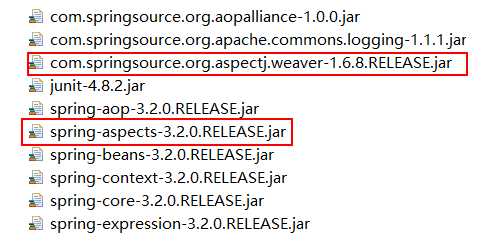
在 spring2.0以后,spring新增了对AspectJ 切点表达式的支持;Aspect1.5新增注解功能,通过 JDK5的注解技术,能直接在类中定义切面;新版本的 spring 框架,也都建议使用 AspectJ 来实现 AOP。所以说在 spring AOP 的核心包 Spring-aop-3.2.jar 里面也有对 AspectJ 的支持。
上一篇博客中,我们在spring配置文件中配置如下:
<!-- 切入点表达式 --> <aop:pointcut expression="execution(* com.ys.aop.*.*(..))" id="myPointCut"/>
那么它表达的意思是 返回值任意,包名为 com.ys.aop 下的任意类名中的任意方法名,参数任意。那么这到底是什么意思呢?
首先 execution 是 AspectJ 框架定义的一个切入点函数,其语法形式如下:
execution(modifiers-pattern? ref-type-pattern declaring-type-pattern? name-pattern(param-pattern) throws-pattern?) 类修饰符 返回值 方法所在的包 方法名 方法抛出的异常
简单点来说就是:
语法:execution(修饰符 返回值 包.类.方法名(参数) throws异常)
具体解释我们用下面一张思维导图来看:

注意:如果切入点表达式有多个不同目录呢? 可以通过 || 来表示或的关系。
<aop:pointcut expression="execution(* com.ys.*Service1.*(..)) ||
execution(* com.ys.*Service2.*(..))" id="myPointCut"/>
表示匹配 com.ys包下的,以 Service1结尾或者以Service2结尾的类的任意方法。
AOP 切入点表达式支持多种形式的定义规则:
1、execution:匹配方法的执行(常用)
execution(public *.*(..))
2.within:匹配包或子包中的方法(了解)
within(com.ys.aop..*)
3.this:匹配实现接口的代理对象中的方法(了解)
this(com.ys.aop.user.UserDAO)
4.target:匹配实现接口的目标对象中的方法(了解)
target(com.ys.aop.user.UserDAO)
5.args:匹配参数格式符合标准的方法(了解)
args(int,int)
6.bean(id) 对指定的bean所有的方法(了解)
bean(‘userServiceId‘)
Aspect 通知类型,定义了类型名称以及方法格式。类型如下:
before:前置通知(应用:各种校验) 在方法执行前执行,如果通知抛出异常,阻止方法运行 afterReturning:后置通知(应用:常规数据处理) 方法正常返回后执行,如果方法中抛出异常,通知无法执行 必须在方法执行后才执行,所以可以获得方法的返回值。 around:环绕通知(应用:十分强大,可以做任何事情) 方法执行前后分别执行,可以阻止方法的执行 必须手动执行目标方法 afterThrowing:抛出异常通知(应用:包装异常信息) 方法抛出异常后执行,如果方法没有抛出异常,无法执行 after:最终通知(应用:清理现场) 方法执行完毕后执行,无论方法中是否出现异常
这里最重要的是around,环绕通知,它可以代替上面的任意通知。
在程序中表示的意思如下:
try{
//前置:before
//手动执行目标方法
//后置:afterRetruning
} catch(){
//抛出异常 afterThrowing
} finally{
//最终 after
}
对应的 jar 包如下:
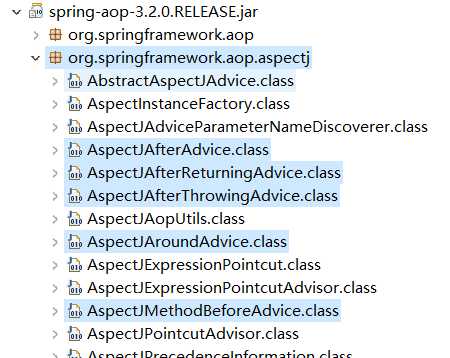
我们可以查看源码:
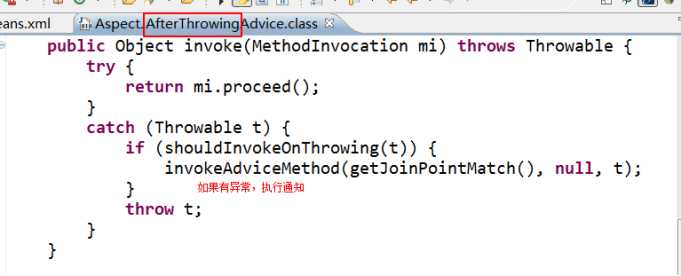

①、创建接口
package com.ys.aop;
public interface UserService {
//添加 user
public void addUser();
//删除 user
public void deleteUser();
}
②、创建实现类
package com.ys.aop;
public class UserServiceImpl implements UserService{
@Override
public void addUser() {
System.out.println("增加 User");
}
@Override
public void deleteUser() {
System.out.println("删除 User");
}
}
③、创建切面类(包含各种通知)
package com.ys.aop;
import org.aspectj.lang.JoinPoint;
public class MyAspect {
/**
* JoinPoint 能获取目标方法的一些基本信息
* @param joinPoint
*/
public void myBefore(JoinPoint joinPoint){
System.out.println("前置通知 : " + joinPoint.getSignature().getName());
}
public void myAfterReturning(JoinPoint joinPoint,Object ret){
System.out.println("后置通知 : " + joinPoint.getSignature().getName() + " , -->" + ret);
}
public void myAfter(){
System.out.println("最终通知");
}
}
④、创建spring配置文件applicationContext.xml
我们首先测试前置通知、后置通知、最终通知
<beans xmlns="http://www.springframework.org/schema/beans"
xmlns:xsi="http://www.w3.org/2001/XMLSchema-instance"
xmlns:aop="http://www.springframework.org/schema/aop"
xsi:schemaLocation="http://www.springframework.org/schema/beans
http://www.springframework.org/schema/beans/spring-beans.xsd
http://www.springframework.org/schema/aop
http://www.springframework.org/schema/aop/spring-aop.xsd">
<!--1、 创建目标类 -->
<bean id="userService" class="com.ys.aop.UserServiceImpl"></bean>
<!--2、创建切面类(通知) -->
<bean id="myAspect" class="com.ys.aop.MyAspect"></bean>
<!--3、aop编程
3.1 导入命名空间
3.2 使用 <aop:config>进行配置
proxy-target-class="true" 声明时使用cglib代理
如果不声明,Spring 会自动选择cglib代理还是JDK动态代理
<aop:pointcut> 切入点 ,从目标对象获得具体方法
<aop:advisor> 特殊的切面,只有一个通知 和 一个切入点
advice-ref 通知引用
pointcut-ref 切入点引用
3.3 切入点表达式
execution(* com.ys.aop.*.*(..))
选择方法 返回值任意 包 类名任意 方法名任意 参数任意
-->
<aop:config>
<aop:aspect ref="myAspect">
<!-- 切入点表达式 -->
<aop:pointcut expression="execution(* com.ys.aop.*.*(..))" id="myPointCut"/>
<!-- 3.1 前置通知
<aop:before method="" pointcut="" pointcut-ref=""/>
method : 通知,及方法名
pointcut :切入点表达式,此表达式只能当前通知使用。
pointcut-ref : 切入点引用,可以与其他通知共享切入点。
通知方法格式:public void myBefore(JoinPoint joinPoint){
参数1:org.aspectj.lang.JoinPoint 用于描述连接点(目标方法),获得目标方法名等
-->
<aop:before method="myBefore" pointcut-ref="myPointCut"/>
<!-- 3.2后置通知 ,目标方法后执行,获得返回值
<aop:after-returning method="" pointcut-ref="" returning=""/>
returning 通知方法第二个参数的名称
通知方法格式:public void myAfterReturning(JoinPoint joinPoint,Object ret){
参数1:连接点描述
参数2:类型Object,参数名 returning="ret" 配置的
-->
<aop:after-returning method="myAfterReturning" pointcut-ref="myPointCut" returning="ret" />
<!-- 3.3 最终通知 -->
<aop:after method="myAfter" pointcut-ref="myPointCut"/>
</aop:aspect>
</aop:config>
</beans>
⑤、测试
@Test
public void testAop(){
ApplicationContext context = new ClassPathXmlApplicationContext("applicationContext.xml");
UserService useService = (UserService) context.getBean("userService");
useService.addUser();
}
控制台打印:
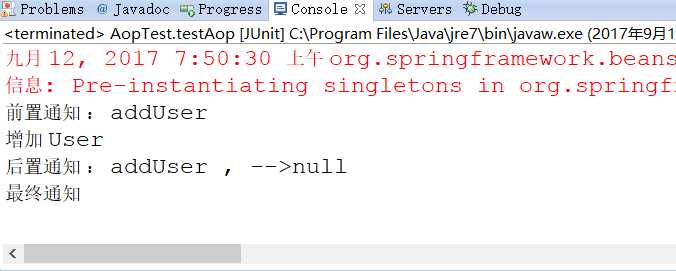
注意,后置通知的返回值为 null,是因为我们的目标方法 addUser() 没有返回值。如果有返回值,这里就是addUser() 的返回值。
目标接口保持不变,目标类我们手动引入异常:
public void addUser() {
int i = 1/0;//显然这里会抛出除数不能为 0
System.out.println("增加 User");
}
接着配置切面:MyAspect.java
public void myAfterThrowing(JoinPoint joinPoint,Throwable e){
System.out.println("抛出异常通知 : " + e.getMessage());
}
接着在 applicationContext.xml 中配置如下:
<!-- 3.4 抛出异常
<aop:after-throwing method="" pointcut-ref="" throwing=""/>
throwing :通知方法的第二个参数名称
通知方法格式:public void myAfterThrowing(JoinPoint joinPoint,Throwable e){
参数1:连接点描述对象
参数2:获得异常信息,类型Throwable ,参数名由throwing="e" 配置
-->
<aop:after-throwing method="myAfterThrowing" pointcut-ref="myPointCut" throwing="e"/>
测试:
@Test
public void testAop(){
String str = "com/ys/execption/applicationContext.xml";
ApplicationContext context = new ClassPathXmlApplicationContext(str);
UserService useService = (UserService) context.getBean("userService");
useService.addUser();
}
控制台打印:

目标接口和目标类保持不变,切面MyAspect 修改如下:
public class MyAspect {
public Object myAround(ProceedingJoinPoint joinPoint) throws Throwable{
System.out.println("前置通知");
//手动执行目标方法
Object obj = joinPoint.proceed();
System.out.println("后置通知");
return obj;
}
}
applicationContext.xml 配置如下:
<!-- 环绕通知
<aop:around method="" pointcut-ref=""/>
通知方法格式:public Object myAround(ProceedingJoinPoint joinPoint) throws Throwable{
返回值类型:Object
方法名:任意
参数:org.aspectj.lang.ProceedingJoinPoint
抛出异常
执行目标方法:Object obj = joinPoint.proceed();
-->
<aop:around method="myAround" pointcut-ref="myPointCut"/>
测试:
@Test
public void testAop(){
String str = "com/ys/around/applicationContext.xml";
ApplicationContext context = new ClassPathXmlApplicationContext(str);
UserService useService = (UserService) context.getBean("userService");
useService.addUser();
}
打印结果:
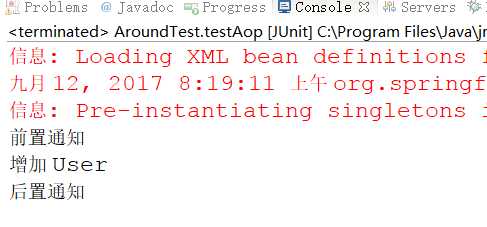
那么至此,通过 xml 配置的方式我们讲解了Spring AOP 的配置。下一章将通过注解的方式来实现。
Spring详解(五)------AspectJ 实现AOP
标签:png user sign 框架 string odi spring配置 alt context
原文地址:http://www.cnblogs.com/ysocean/p/7507993.html